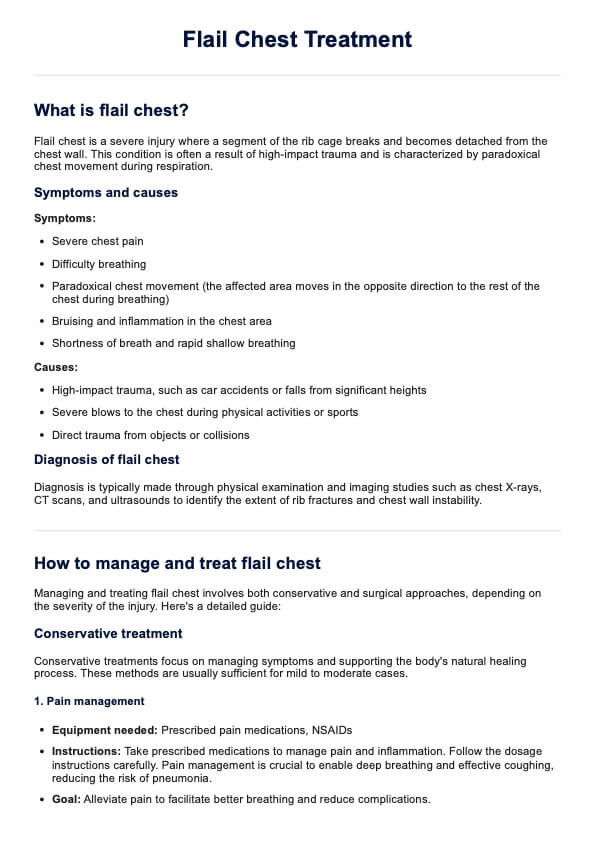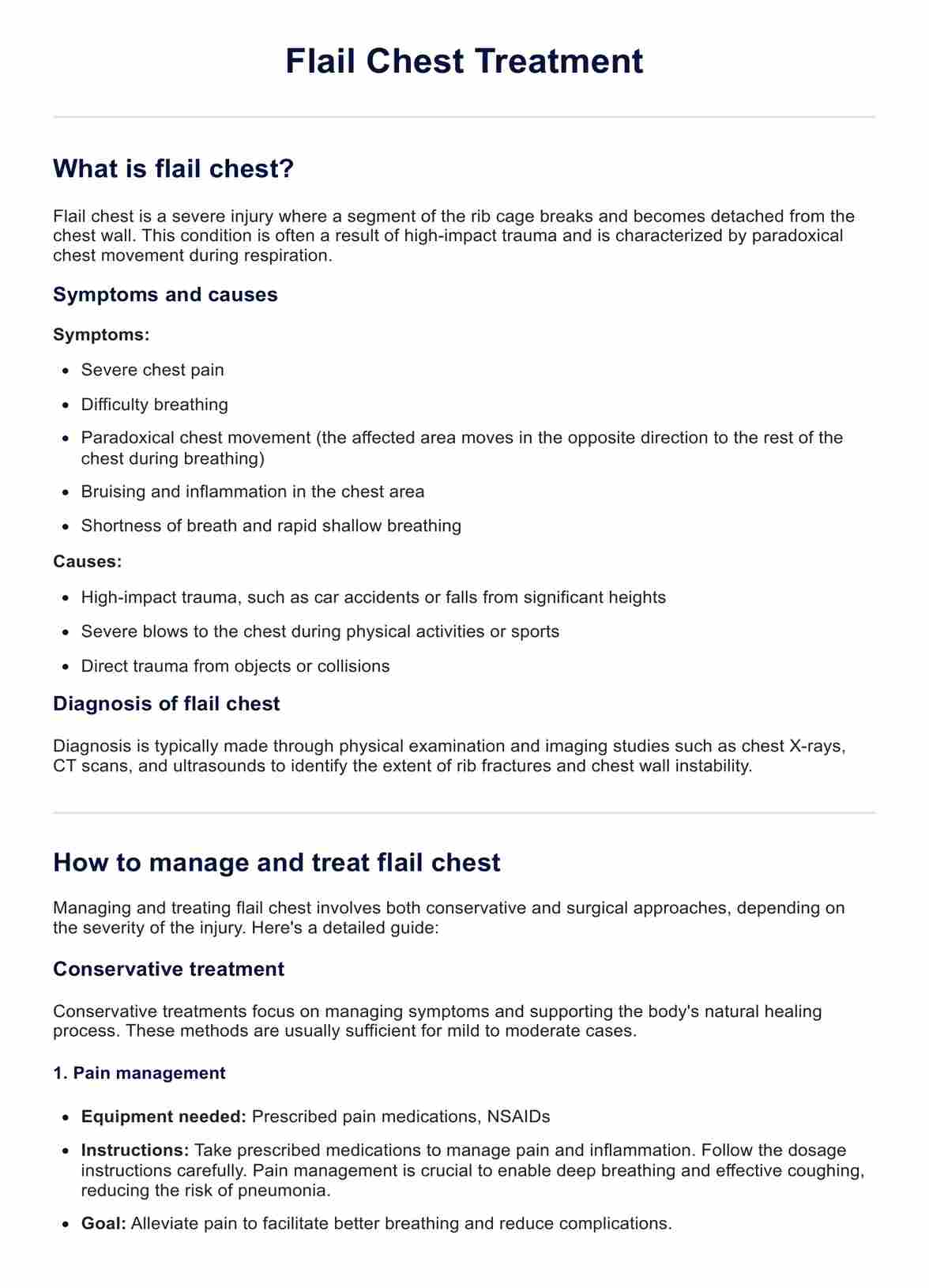Flail Chest Treatment Handout
Discover comprehensive guidelines for treating flail chest. Learn about causes, symptoms, and effective treatment options for optimal patient care.


What is a flail chest?
Flail chest is a serious condition when a segment of the chest cavity or rib cage breaks under extreme stress and detaches from the rest of the cavity, causing chest wall injuries elsewhere. This injury is most commonly caused by high-impact trauma and requires immediate medical attention to prevent life-threatening complications.
Causes of flail chest
Flail chest is a traumatic disorder typically the result of severe blunt trauma done to the front chest wall. Understanding the causes can help in the prevention and management of this condition.
- High-impact trauma, such as road traffic accidents
- Falls from significant heights
- Direct blows to the chest during sports or physical altercations
Symptoms of flail chest
Recognizing the symptoms of flail chest is crucial for prompt diagnosis and treatment. These symptoms indicate the severity of the injury and the need for urgent care.
- Severe pain at the site of the fractures
- Difficulty breathing and shortness of breath
- Paradoxical movement of the chest wall (the affected segment moves inward during inhalation and outward during exhalation)
- Bruising and swelling over the affected area
- Cyanosis (bluish color of the skin due to lack of oxygen)
Flail Chest Treatment Handout Template
Flail Chest Treatment Handout Example
How to treat flail chest
Effective treatment of flail and chest injuries involves both conservative and surgical methods. Treatment choice depends on the severity of the flail chest injury and the patient's overall health.
Conservative treatment
Conservative treatment aims to manage pain, ensure adequate oxygenation, and support lung function. It is usually the first line of treatment for less severe cases.
Pain management
Effective pain relief is crucial for patients with a flail chest. Analgesics, including non-steroidal anti-inflammatory drugs (NSAIDs), opioids, or nerve blocks, can be administered to manage pain. Adequate pain control allows patients to breathe deeply and cough effectively, reducing the other risk factors of lung complications.
Oxygen therapy
Providing supplemental oxygen helps maintain adequate oxygen levels in the blood. This is especially important for patients experiencing respiratory distress. Oxygen can be delivered via nasal cannula, face mask, or high-flow oxygen devices.
Breathing exercises
Teaching patients breathing exercises like deep breathing and incentive spirometry can improve lung function and prevent complications like atelectasis (collapsed lung). These exercises encourage full lung expansion and facilitate mucus clearance.
Surgical treatment
Surgical treatment is considered for severe cases where conservative methods are insufficient. It involves procedures to stabilize the chest wall and support respiratory function.
Rib stabilization
In severe cases of flail chest, surgical stabilization of the broken ribs may be necessary. This involves using metal plates and screws to fix the fractured ribs in place, restoring the stability of broken ribs to the chest wall. Rib stabilization can reduce pain, improve respiratory function, and shorten recovery time.
Mechanical ventilation
Mechanical ventilation may be required for patients with significant respiratory distress or those unable to maintain adequate oxygenation. This involves intubation and connection to a ventilator to support breathing and ensure proper oxygen delivery to the lungs.
How to use our Flail Chest Treatment Handout?
This handout is designed to help healthcare professionals effectively communicate the treatment and management of flail chest to their patients. It provides clear, step-by-step instructions and essential information to ensure patients understand and follow their care plan correctly.
Step 1: Understand the contents of the handout
Before distributing the handout, familiarize yourself with its contents, including the definition of flail chest, symptoms, causes, diagnosis methods, and conservative and surgical treatment options. This ensures you can answer any questions your patients might have.
Step 2: Identify appropriate patients
Determine which patients will benefit most from the handout. It is beneficial for those diagnosed with flail chest due to high-impact trauma, such as major trauma such as car accidents or falls. Ensure patients understand that this handout is a comprehensive guide to their treatment and recovery process.
Step 3: Provide the handout during consultations
Distribute the handout during patient consultations, especially after diagnosing the symptoms of flail chest first. Go through the critical sections with your patient, emphasizing the importance of each treatment option and what they can expect during their recovery journey.
Step 4: Explain the importance of each section
Highlight the importance of following the guidelines outlined in the handout. Discuss the conservative treatments such as pain management, oxygen therapy, and breathing exercises, as well as surgical options like rib cage stabilization and mechanical ventilation. Ensure patients understand how each treatment contributes to their recovery.
Step 5: Encourage questions and follow-ups
Encourage patients to ask questions about any part of the handout they find confusing or concerning. Schedule follow-up appointments to monitor their progress and adjust treatment plans as necessary. Reinforce the importance of attending all follow-ups and adhering to the care instructions.
How will healthcare professionals benefit from this handout?
Using a well-structured handout for flail chest treatment provides numerous advantages for healthcare professionals. These benefits enhance the quality of patient care and streamline the treatment process.
Improved patient education
This handout allows healthcare professionals to provide patients with clear and concise information about flail chest injuries. By outlining the causes, symptoms, and treatment options for flail chest injuries in an easy-to-understand format, patients are better informed about their condition and the necessary steps for recovery.
Standardized treatment approach
A comprehensive handout ensures that all healthcare professionals follow a standardized approach to treating flail chests. This consistency helps maintain high-quality care across different practitioners and facilities, reducing the risk of treatment errors and improving patient outcomes.
Enhanced patient compliance
Patients who understand their condition and the rationale behind their treatment plan are more likely to comply with medical advice. This handout empowers patients with the knowledge to follow through with their treatment, leading to better recovery and reduced complications.
Commonly asked questions
Flail and chest trauma are typically caused by high-impact chest trauma, such as road traffic accidents, falls from significant heights, or direct blows to the front chest cavity during sports. These injuries result in multiple rib fractures that detach a segment of the chest wall.
Flail chest is diagnosed through physical examination and imaging studies such as X-rays or CT scans. The characteristic symptom is paradoxical movement of the chest wall, where the injured segment of the chest wall moves outward and in the opposite direction of the rest of the chest during breathing.
Complications of flail chest can include respiratory failure, pneumonia, and other lung infections. The condition can also lead to significant pain and discomfort, requiring careful management and monitoring.







































































































